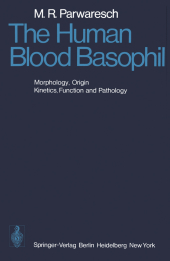 Neuerscheinungen 2011Stand: 2020-01-07 |
Schnellsuche
ISBN/Stichwort/Autor
|
Herderstraße 10
10625 Berlin
Tel.: 030 315 714 16
Fax 030 315 714 14
info@buchspektrum.de |

K. Lennert, M. R. Parwaresch
(Beteiligte)
The Human Blood Basophil
Morphology, Origin, Kinetics Function, and Pathology
Mitarbeit: Lennert, K.
Softcover reprint of the original 1st ed. 1976. 2011. xiv, 238 S. XI, 235 pp. 58 figs. some in colour
Verlag/Jahr: SPRINGER, BERLIN 2011
ISBN: 3-642-66331-1 (3642663311)
Neue ISBN: 978-3-642-66331-4 (9783642663314)
Preis und Lieferzeit: Bitte klicken
The blood basophils lead a shadowy existence in the field of hematology, even now, 100 years after their discovery by PAUL EHRLICH. In clinical medicine they were hardly noticed for many decades, since they occur in such small numbers in the blood that small and moderate variations in the basophil count were not detectable with common count ing methods. This situation has changed since the in troduction of direct counting methods. It was noticed, for example, that the blood basophil count is increased in hy perlipemia. In the field of pathology the blood basophil was prac tically overlooked until recently. This was due to the fact that with common fixations in aqueous solutions the granules dissolve, so that the cells can no longer be stained specifically and therefore escape observation. This problem was solved through special fixing solu tions. However, interest in the blood basophils remain ed confined to only a few research groups.
A. Basophils of the Peripheral Blood.- I. Basophil Count.- 1. Normal Values; Counting Procedures.- 2. Basophil Leukocytosis and Basopenia.- a) Thyroid Hormone.- b) Pituitary and Adrenal Hormones.- c) Sex Hormones.- d) Insulin.- e) Other Factors.- II. Light-Microscopic Morphology.- III. Phase-Contrast Microscopic Morphology.- IV. Electron-Optical Morphology.- References.- V. Cytochemistry of Blood Basophils.- 1. Lipids.- 2. Glycogen.- 3. Acid Mucopolysaccharides (Glycosaminoglycans).- a) Bismarck Brown.- b) Colloidal Iron.- c) Phthalocyanine Stains.- d) Aldehyde Fuchsin.- e) The PAS-Reaction.- f) Thiazine Dyes.- g) Metachromasia.- 4. Enzymes.- a) Oxidoreductases.- b) Hydrolases.- 5. Biogenic Amines (Histamine).- 6. Trace Elements (Zinc, Copper).- 7. Amino Acids.- References.- VI. Comparative Studies on the Morphology of Blood Basophils.- References.- B. The Origin of Blood Basophils.- I. Literature Review.- II. Detection of Blood Basophils and Their Precursors in Normal Human Bone Marrow.- 1. Qualitative Findings.- a) Application of Basic Dyes.- b) Detection with the Naphthol AS-D Chloro-acetate Esterase Reaction.- 2. Quantitative Findings.- a) Cytophotometric Determination of the Naphthol AS-D Chloroacetate Esterase Activity in Basophil Granulopoietic Cells.- b) The Quantitative Composition of Basophil Granulopoietic Cells in Human Bone Marrow.- III. Evidence of Basophil Descent from Promyelocytes.- References.- C. Biochemistry and Function of Blood Basophils.- I. Heparin in Blood Basophils.- 1. Evidence of Heparin in Basophil Granules.- 2. Biochemical-Functional Significance of Heparin.- a) Biological Properties of Heparin and its Structure-Action Relationships.- b) Anticoagulant Activity of Heparin.- c) Blood Basophils and Heparin-Induced Serum Lipolysis.- References.- II. Histamine in Blood Basophils.- 1. Detection of Histamine in Basophils.- 2. Biochemical-Functional Significance of Histamine.- a) Structure-Activity Relationship of Histamine.- b) Immunological Significance of Blood Basophils.- ?) Blood Basophils in Immune Reactions of the Immediate Type.- ß) Blood Basophils in Immune Reactions of the Delayed Type. (Histopathology of the Jones-Mote Reaction).- References.- III. Granulolysis and Kinetic Properties of Blood Basophils.- 1. The Degranulation Mechanisms of Blood Basophils.- 2. Kinetics of Blood Basophils in Rabbits.- 3. Kinetics of Human Blood Basophils.- 4. The Effect of Compound 48/80 on Rabbit Basophils.- a) In-vivo Tests.- b) In-vitro Tests.- References.- D. The So-Called Basophilic Leukemias.- I. Review of the Literature.- II. Clinical and Pathoanatomical Features.- 1. Primary Basophilic Leukemia.- 2. Secondary Basophilic Leukemia.- III. Cytomorphology and Cytogenesis of Leukemic Blood Basophils.- IV. Nosology of the So-Called Basophilic Leukemia.- References.


